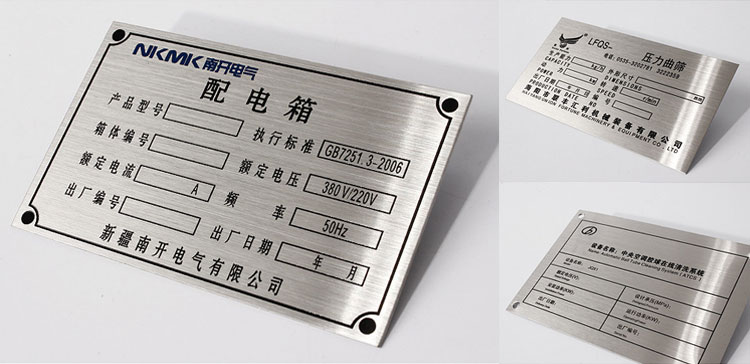Common Material Comparison of Custom Made Metal Name Plates
In recent years, custom made metal name plates have been widely used in the fields of electronic products, home appliances, machinery and civil products. The production materials of custom made metal name plates are mainly aluminum, copper, stainless steel, and zinc alloys, which are completed by stamping, die-casting, etching, printing, and other processes.
There are many kinds of metal sign making, briefly introduce several common sign materials:
Custom Aluminum Nameplates
Among the metal sign products, the proportion of aluminum signs accounts for more than 90% of the metal signs. For more than half a century, the use of aluminum nameplates to make signs has been enduring for a long time. The main reason is that aluminum has the most decorative performance. force and its series of excellent properties.
Advantage
- Lightweight
The density of aluminum is 2.702gNaN3, which is only 1/3 of that of copper and aluminum. Aluminum signs will not increase the weight of the equipment, and also save costs. - Has a strong metallic luster
There are many processes for making aluminum nameplates. Stamping transforms the appearance of aluminum plates, and high-gloss technology polishes the aluminum name plates so that the aluminum signs have good brightness. - Strong plasticity
Excellent ductility of aluminum, convenient for grinding, cutting, and corresponding mechanical operations, and can meet the needs of special craftsmanship for signs. - Good corrosion resistance
On the surface of aluminum and its alloys, a hard and dense oxide film can be formed, and many substances do not corrode the aluminum oxide film, and it will have excellent durability in harsh environments in industrial areas and coastal areas. - No magnetism
Aluminum is a non-magnetic body, and aluminum signs will not cause external disturbance to equipment. - Can provide the function of night light.
Disadvantages
The hardness is not enough, when subjected to a strong external force, the sign will be deformed, and the melting point of aluminum is low, so the aluminum sign will quickly “die” at high temperatures.
Application
It is suitable for distributing some high-end places as logos, and can also be used for places that need logos such as furniture, decoration, automobiles, offices, etc.
Stainless steel nameplate
The stainless steel nameplate has strong rigidity, and its high strength also reflects its value. It is often used in outdoor scenes that may be subjected to strong external forces. There are also many types of stainless steel, and different types have different strengths and plasticity.
Advantage
- It will not rust, and its service life is longer than that of other materials.
- The stainless steel sign is light in weight and not easy to fall off.
- Has a strong metallic texture.
- The surface craft effects are brushed and mirror.
Disadvantages
Stainless steel also belongs to iron, and its density is very high, so it has long increased its weight, which will cause great inconvenience to transportation and installation.
Application
It is often used for equipment nameplates of machinery manufacturers, because high temperatures may be encountered when machinery and equipment are working, so the high melting point of stainless steel comes in handy.
Copper nameplate
The copper nameplate itself has a golden or bronze color, which is why many manufacturers need it. For example, medals, gold medals and related anti-gold handicrafts and artworks, in the process of sign production, many processes will be used to transform copper signs, bright colors and so on.
Today, the demand for copper nameplates is no less than that of aluminum nameplates. Both have their own strengths and weaknesses. The bronze medal has a large weight and a complicated production process.
GreatNameplates mainly produces metal cards, metal nameplates, metal tags and metal gift accessories.
Welcome to consult, custom metal nameplate!
Ms. Edith
Email: info@greatnameplates.com
Whatsapp: +8613612933572
Skype: live: greatnameplates





